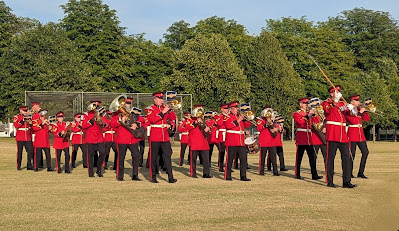Castlefields Field
The earliest mention of Castlefield is in 1552 in the church register
[1], which was a common field, however after the enclosures of the early 1800s, 33 acres was converted into a park for
Castlefields House.
A 1728 map shows the area of Castlefields to be strips of land, which one field called 'Little Castle Field'. However, by 1828, Henry Alworth Merewether (See
Castlefields House) owned most of what was still known as Castlefields, with the Marquis of Lansdowne and the Society of Friends owning small parcels.
At least some of the land was still being used for farming in the 1920s, as a photograph showing freely ranging chickens and a thatched rick at the area of Chaveywell show
s[2].
Between the 1960s and 1980s, the northern part of Castlefields was developed as the
Curzon Park bulgalow estate.
Castlefields Canal and River Park
The southern area, which includes the canal and the river Marden, has been turned into Castlefields Canal and River Park and has been well managed and improved by Castlefields Canal and River Park association since 2001 when it was still owned by Wiltshire Council
[3].
A short history:
In 2000 North Wiltshire District Council established the North Wilts River Route, which leads through and out of Castlefields to Chippenham, a 16 km cycle and pedestrian route
In 2010 there was an archaeological dig by Wiltshire Archaeological and Natural History Society in the park to identify the site of Calne's castle. It was discovered that a fortified tower house was locate din the area (see
Castle entry).
In 2011 Hills Homes funded the restoration of the former lock and the replica narrow boat, known as the Jubilee Queen, which was completed in 2012.
In 2012 the area was transferred to Calne Town Council as a community asset for the fee of £1. The same year a ring of trees was planted to celebrate the Diamond Jubilee of Queen Elizabeth II, these surround an inner circle of Scots Pines, which commemorate the Diamond Jubiliee of Queen Victoria in 1897. Upper Castlefields park also contains an outline of Calne castle made of cotoneaster.
January 2013 saw Castlefields become a 2 hectare Fields in Trust site with Queen Elizabeth II fields protection, which protects parks and green spaces throughout the UK in perpetuity.
In 2015, it was agreed that the Section 106 agreement for the Station Meadow development would be used to repair the historic wall, which is a complex project including the removal of trees, demolition and partial removal of some of the wall, along with re-building and stabilisation of the wall.
2016 saw the improvements of sports equipment and fitness trail in the park, initially completed in 2005.
In 2017 came the lovely mosaic for the art festival.
In August 2018 Jubiliee Queen was restored and painted and re-stickered, while in 2019 4000 crocus bulbs were planted by volunteers as part of the Rotary Club's 'End Polio Now' campaign.
 |
| Castlefields House |
Castlefields House
Castlefields house was built c. 1828 for Henry Alworth Merewether (1780-1864), serjeant-at-law, king's counsel, and Town Clerk for the City of London between 1842 and 1859. In 1835, along with Archibald John Stephens, he wrote his principal work, '
The History of the Boroughs and Municipal Corporations of the United Kingdom'. This three volume work detailed the history from the earliest British Period, through the Roman and Saxon period, to his present time.
For a time, it seems that the house, which sat in a 33 acre piece of land and gardens, may have been known at The Hermitage. Certainly there was an area called The Hermitage on Curzon Street that consisted of a barn, stable, and cart house, as well as a later addition of the Hermitage Cottages, on what was most likely land owned by Stanley Abbey. Perhaps it gained The Hermitage as an informal name due to proximity.
The Grade II listed house is built in Tudor Revival Style and uses crenellation on the porch and cornices, perhaps to make a connection with the romantic idea of how a castle would have looked.
The house became a residential care home between 1983 - 2000 and has since been converted into a seven bedroom, four bathroom holiday rental costing between £700-£1500 per night.
26 Castle Street, a Grade II listed building, was the lodge to Castlefields House. The gate piers for Castlefield House also still exist and mark the entrance to the Castlefield housing estate.
 |
| Castlefields |
Castlefields
Castlefields is a small development of bungalows on land, at one time, held by Castlefields House. They were likely built by
George Hazell's firm c. 1962, who had acquired a large part of the Castlefields House estate, with Ron Sutton aquiring the northern part of the estate, the drive of which lead to Curzon Street by the lodge (see also, Curzon Park Estate, Lodge Close)
[4].
References:
[1] Marsh, A., 1903. A HISTORY OF THE BOROUGH AND TOWN OF CALNE. 1st ed. London: HAZELL, WATSON AND VINEY, LTD.
[2] Treloar, P. (1999). Calne Revisited. 1st ed. Calne Town Council.
[3] Welcome To CARP. 2019. Welcome To CARP. [ONLINE] Available at: http://www.calne-castlefieldspark.co.uk. [Accessed 10 October 2019].
[4] Calne in Photographs public group | Facebook. 2019. Calne in Photographs public group | Facebook. [ONLINE] Available at: https://www.facebook.com/groups/CalnePhotographs/permalink/474667803123217/. [Accessed 13 October 2019].





















